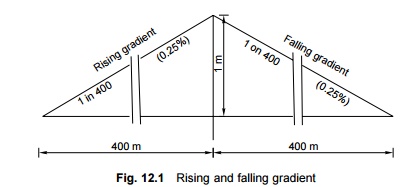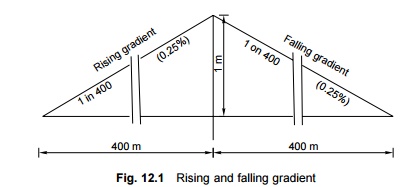Chapter: Civil : Railway Airport Harbour Engineering : Railway Engineering : Geometric Design of Track
Gradients of Track

Details of Geometric
Design of Track
The geometric design of the track deals with the various
aspects described in the following.
Alignment of railway track The
subject of railway track alignment has been covered in Previous Pages.
Curves Details regarding curves and
their various aspects have been discussed in Previous Pages.
Gradients Details
regarding gradients are discussed in the following section.
Gradients of Track
Gradients are provided to
negotiate the rise or fall in the level of the railway track. A rising gradient
is one in which the track rises in the direction of the movement of traffic and
a down or falling gradient is one in which the track loses elevation in the
direction of the movement of traffic.
A gradient is normally represented by the distance
travelled for a rise or fall of one unit. Sometimes the gradient is indicated
as per cent rise or fall. For example, if there is a rise of 1 m in 400 m, the
gradient is 1 in 400 or 0.25%, as shown in Fig. 12.1.

Gradients
are provided to meet the following objectives.
(a) To reach
various stations at different elevations
(b) To follow
the natural contours of the ground to the extent possible
(c) To reduce
the cost of earthwork.
The
following types of gradients are used on the railways.
(a) Ruling
gradient
(b) Pusher or
helper gradient
(c) Momentum
gradient
(d) Gradients
in station yards
1 Ruling Gradient
The ruling gradient is the
steepest gradient that exists in a section. It determines the maximum load that
can be hauled by a locomotive on that section. While deciding the ruling
gradient of a section, it is not only the severity of the gradient but also its
length as well as its position with respect to the gradients on both sides that
have to be taken into consideration. The power of the locomotive to be put into
service on the track also plays an important role in taking this decision, as
the locomotive should have adequate power to haul the entire load over the
ruling gradient at the maximum permissible speed.
The extra force P required by a locomotive
to pull a train of weight W on a gradient with an angle of inclination q is
P = W Sin
q
= W tan q
(approximately, as q is very
small) = W × gradient
Indian Railways does not specify
any fixed ruling gradient owing to enormous variations in the topography of the
country, the traffic plying on various routes, and the speed and type of
locomotive in use on various sections. Generally, the following ruling
gradients are adopted on Indian Railways when there is only one locomotive
pulling the train.
In plain terrain: 1 in 150 to 1 in 250 In hilly terrain: 1 in
100 to 1 in 150
Once a ruling gradient has been
specified for a section, all other gradients provided in that section should be
flatter than the ruling gradient after making due compensation for curvature.
2 Pusher or Helper Gradient
In hilly areas, the rate of rise
of the terrain becomes very important when trying to reduce the length of the
railway line and, therefore, sometimes gradients steeper than the ruling
gradient are provided to reduce the overall cost. In such situations, one
locomotive is not adequate to pull the entire load, and an extra locomotive is
required.
When the gradient of the ensuing
section is so steep as to necessitate the use of an extra engine for pushing
the train, it is known as a pusher or helper gradient. Examples of pusher
gradients are the Budni-Barkhera section of Central Railways and the Darjeeling
Himalayan Railway section.
3 Momentum Gradient
The momentum gradient is steeper
than the ruling gradient and can be overcome by a train because of the momentum
it gathers while running on the section. In valleys, a falling gradient is
sometimes followed by a rising gradient. In such a situation, a train coming
down a falling gradient acquires good speed and momentum, which gives
additional kinetic energy to the train and allows it to negotiate gradients
steeper than the ruling gradient. In sections with momentum gradients there are
no obstacles provided in the form of signals, etc., which may bring the train
to a critical juncture.
4 Gradients in Station Yards
The gradients in station yards are quite flat due to the
following reasons.
(a) To
prevent standing vehicles from rolling and moving away from the yard due to the
combined effect of gravity and strong winds.
(b) To reduce
the additional resistive forces required to start a locomotive to the
extent
possible.
It may be mentioned here that generally, yards are
not levelled completely and certain flat gradients are provided in order to
ensure good drainage. The maximum gradient prescribed in station yards on
Indian Railways is 1 in 400, while the recommended gradient is 1 in 1000.
Grade Compensation on Curves
Curves provide extra resistance
to the movement of trains. As a result, gradients are compensated to the
following extent on curves
(a) On BG
tracks, 0.04% per degree of the curve or 70/R, whichever is minimum
(b) On MG
tracks, 0.03% per degree of curve or 52.5/R, whichever is minimum
(c) On NG
tracks, 0.02% per degree of curve or 35/R, whichever is minimum where R
is the radius of the curve in metres. The gradient of a curved portion of the
section should be flatter than the ruling gradient because of the extra
resistance offered by the curve.
Example Find the
steepest gradient on a 2 o curve for a BG line with a ruling gradient of
1 in 200.
Solution
(i) Ruling
gradient = 1 in 200 = 0.5%
(ii) Compensation
for a 2 o curve = 0.04 × 2 = 0.08%
(iii) Compensated
gradient = 0.5 - 0.08 = 0.42% = 1 in 238 The steepest gradient on the curved
track is 1 in 238.
Related Topics